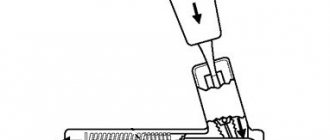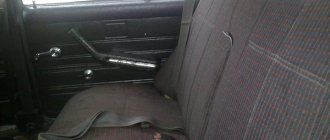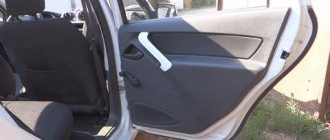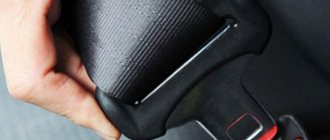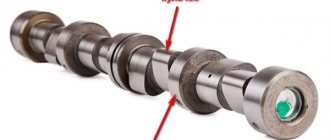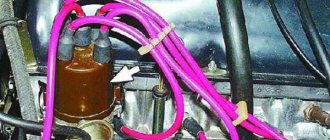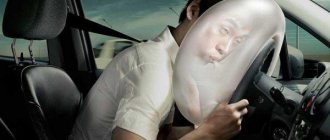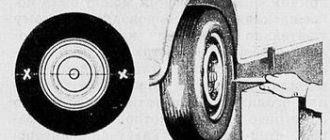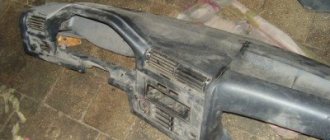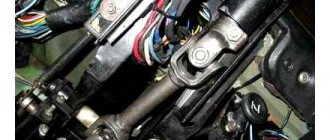07/17/2021 18,439 VAZ 2106
Author: Ivan Baranov
A car is a place where a person is often in danger. Therefore, modern cars are equipped with various systems and means that increase the safety of the driver and passengers. These devices include seat belts. In early versions of VAZ 2106 cars, rear belts were not installed at the factory, although fastenings were provided for them. The article describes: the purpose of rear seat belts, how to install them yourself on a VAZ 2106.
[Hide]
Belt device
If the belt does not come out of its slot, it is most likely jammed. To fix the problem, you need to understand the principle of this element of the car. With such a breakdown, there is a high probability that it is the locking mechanism that is not working correctly. Sometimes the belt may not stretch after an accident. There is a special technology for eliminating such breakdowns.
The first step is to understand the seat belt design. There is a special element inside the locking mechanism that is responsible for fixation. It looks like a ball that moves through levers. At the same time, it clings to the gears of the coils.
The seat belt latch reacts when it is pulled out too quickly, blocking the ball. It is in this system that problems may appear over time. In this case, the belt may not stretch or, conversely, may remain locked in the fastened position.
Design and operating principle
The design of the protective device in question is represented by a retractor reel, a lock and a tape. High-strength material is used to make the tape; this element is fixed to the body in several zones as follows:
- in the area of special traction with a lock;
- on the counter;
- in the threshold area.
The main purpose of the lock, in turn, is to lock the belt. This element is located near the seat. A movable tongue made of durable metal simplifies the operation of the belt; it is located directly on the belt. You can find a retractor coil on the car body pillar. Its purpose is to forcefully wind and unwind the tape. The design of the retractor reel provides for the presence of an inertial locking mechanism, due to which, in the event of a sudden stop, the movement of the belt is stopped and the person remains in a fixed position, not being able to go into free flight through the windshield.
The principle of operation is nothing complicated: the action of a coil with a blocker is based on a gear mechanism that rotates it. The closing of this mechanism occurs through a pendulum; it can have a ball or spheroid support with a lever system.
Smooth unwinding of the tape promotes rotation of the support along with the reel gear, while sudden tension leads to blocking of the flywheel.
Installing three-point seat belts
The most common structural element of a car's safety system is seat belts. Their main purpose is to prevent a person from falling and dangerously moving during a collision or sudden braking. Wearing seat belts is the easiest way to improve your safety in any vehicle.
The Star Motors auto repair center provides its customers with a full range of repair and maintenance services for domestic and foreign cars of all brands. For several years now, our company has been specializing in vehicle refurbishment. One of the main stages of re-equipment of Crafter, Hyundai, Startes, Vaneo, Vito, Multivan, Caravella cars is the installation of seat belts. It should be noted that currently most buses in use are not equipped with seat belts.
Today the following types of seat belts are used:
- two-point static seat belts;
- three-point inertial seat belts;
- four-point seat belts;
- inflatable seat belts.
Our specialists install three-point seat belts. This belt includes a strap, a lock and a retractor. Durable materials are used for its manufacture. Using special devices, the strap is attached to the body at three points: on the threshold, on the rack and on a special rod with a lock. Modern cars are equipped with seat belts with tensioners.
The main advantages of such seat belts include:
- this option will cost much less than installing “original”, i.e. branded belts;
- ensuring the ability to maintain the ability to transform the interior;
- Seat belts can be installed on seats that have been previously removed from the vehicle.
In addition, if necessary, you can install any number of belts. So, our craftsmen will be able to install three protective belts on the rear three-seater sofa.
It should be noted that different categories of vehicles have their own minimum requirements for the installation of seat belts. If you wish, you can clarify all the details regarding your car model with our specialists.
Installation of seat belts is carried out by experienced specialists of the Star Motors auto repair center in the shortest possible time. All installed seat belts have all the necessary certificates. We also provide assistance in preparing all documents for the traffic police. Our company has all the necessary permits for the installation of seat belts and issues certificates to customers for the traffic police, allowing them to make marks in the registration documents for the vehicle.
To install belts, call us: working hours: Mon-Fri 9:00-21:00, Sat-Sun 10:00-21:00 address: Moscow, Strogino district, st. Marshala Proshlyakova, 32
Lada 2107 Pensamiento clásico › Logbook › Seat belt jamming.
In general, I’m writing in the heat of the moment—it was in the heat of the moment that the problem appeared and I quickly fixed it. I'm sure most people experience a seat belt getting stuck. My belt was completely jammed and did not want to come out. Naturally, the time has come to deal with this problem completely. First, I unscrewed the entire belt structure, and as a result we have this thing with covers on both sides.
the cover is narrow, that’s what we’ll remove
I don’t even know what’s under this lid, it’s better not to touch it. Next, I knocked out 4 white cotter pins from the inside with an awl, they are what hold the lid. We remove the cover and see this design.
It’s this system that stops the belt. The whole problem is in the ball and its seat. The ass-handed designers did not foresee that the ball could fall out and thereby jam the plastic rocker, which blocks the stopper.
ill-fated box with a ball In general, based on everything seen, there are 3 ways to solve this problem: drill out the seat for the ball to prevent it from falling out, remove the ball completely (it will stop wedging the rocker, the belt will become loose, the lock will not work if you pull it sharply), remove the rocker and ball (the belt will become completely free without locking).
The rocker and ball have been removed
Only the ball was removed I removed only the ball and the result made me very happy. The belt began to work smoothly and softly without jamming. It remains to do the same procedure on the passenger side because my fellow travelers are constantly swearing while trying to get the belt)))
UAZ 469 Turbo-Bobik 2.9 TD › Logbook › Seat belts
It’s happened, for 3 years I haven’t gotten around to wearing seat belts, either they asked for it dearly, or they were dirty, or for some other reason! Well, as they say, every cloud has a silver lining, or in this case, vice versa! A week ago I was in an accident, a car from the oncoming lane jumped onto my side and hit me in the forehead!
To be honest, I now enjoy driving not only as a passenger but also behind the wheel! So I decided to make Bobik’s belts at the first opportunity! I found the belts at the auction and bargained for 2000 tenge ($11) They said that it was some kind of adapter from Mazda
I can’t do without modernization, we drill out the rivet on the back plate and cut off the excess iron!
The mechanism itself was attached to the place where the roof is attached so as not to add any new holes or reinforcements there.
Well, here I think there’s no need to comment, everyone adjusts the height to suit themselves
Moms from the belts secured to their original places on the seats
Well, in general, this is how it turned out
Today I already made a test drive into the city, the feeling of security began to be present)))
Repair process
Now that we have dealt with the signals and reasons for blocking a fastened and unfastened seat belt, let’s move on to the repair process. Cleaning seat belts is one of the main tasks in this process, so we will consider this procedure separately. So, what should you do if you receive a signal that the lock is jammed? How can I clean it or turn it off? You will learn more about this below.
Tools
To disable the lock if a corresponding signal appears, the entire mechanism will need to be cleaned. To do this, you need to thoroughly prepare in advance and collect all the necessary tools. so what to prepare:
- a Phillips screwdriver, preferably a short one;
- flat head screwdriver;
- a wrench set to “17”, it will be more convenient to use a socket wrench;
- stationery pin;
- syringe with tube;
- some gasoline (lighter fuel is ideal).
Step by step instructions
When the entire list of tools is ready, you can begin repairing and cleaning.
Using a Phillips screwdriver, unscrew the screws that secure the strap protection. If the lock is not working, pull the strap out to its full length and secure it with a clothespin. Take a wrench and remove the screw that secures the element coil. The screw must be removed from its installation location. To prevent the element from starting to unwind, you can attach it directly to the same spool using the same clothespin. In any case, in order to disable and clean the lock, it must be locked to make further actions easier. Put the reel aside and sit in the next seat. To disable and clean the lock, you will need to find the lid behind which the inertial device is hidden. As a rule, it is slightly thicker in design. Shake the coil - under which cover you hear the noise - under that one it is located. Now to dismantle the protective cover you will need to remove four plastic pistons. This can be done using a slotted screwdriver or a thin knitting needle. The pistons should be supported by hand so that they do not fly out and you do not have to look for them and collect them throughout the cabin. Then pry up the cover with a screwdriver and remove it. Set the lid aside. Your view will now be presented with the first mechanism of the component. It is a kind of box with a cylinder and thus a locking ball and a so-called rocker inside, which jams the lock. This mechanism can be dismantled freely from the installation site. Check the functionality of this rocker - ideally it should move freely along the axis of rotation. This device should be positioned vertically with the top angled toward the locking ball. One way or another, the rocker arm must be positioned vertically so that it does not jam. If you feel that the so-called rocker arm does not move freely, then you need to clean its rotation axis. Pour some gasoline and rinse the device until it rotates freely on the axis, without the slightest jamming. Now let's move on to the second, inertial device. It is located under the gear, made of plastic and in most cases made of steel
The gear comes off freely, so remove it. Note the center of the serrated hole. It contains an eccentric with teeth
It is these teeth that jam the strap when it is suddenly pulled out. The space under this very eccentric needs to be cleaned. Pour a little prepared gasoline around the entire perimeter of the hole, add a little fuel to the center. At the same time, hold the strap, preventing it from winding up, for which you can temporarily remove the clothespin. Make sure that the liquid gets into all parts of the element, otherwise cleaning it will be useless. Take the dismantled spool with one hand so that the plastic guide along with the spring can be supported with one finger. Using your other hand, pull and wrap the safety element several times. Also pull it a few times until the device itself engages. Next, hook it on the reel one more time. These steps should be repeated several times.
At this point, the cleaning process of the mechanism can be considered complete. You should carry out all further assembly in reverse order. Do everything correctly, because an incorrectly assembled mechanism will cause breakdowns in the near future with regular use of the straps.
Troubleshooting seat belt problems
First, you need to take into account that driving with a faulty strap is not only dangerous for life, but can also hit the car owner’s pocket.
But still this is not as important as the safety of the motorist. Of course, if a seat belt extender or other structural component fails, you can always contact a service station, where specialists will do everything efficiently
But you will need to pay a certain amount of money to repair a seat belt buckle or other element. However, if necessary, you can always complete the entire repair process at home.
As for malfunctions, there can be many of them, but we will look at the most common problems that our motorists encounter. One of the most common problems is the inability of the strap to screw back on. That is, after the driver reaches his destination and unfastens the strap, it remains in the same form and does not twist back.
Of course, the situation is not particularly pleasant, but this problem can be solved. As a rule, the reason is a failed spring installed in the drum. Therefore, to solve the problem, you will simply need to replace this spring.
What happens just as often is that the strap does not come out of its installation location; in this case, it is most likely simply jammed. If the seat belt for dogs or people cannot be pulled out, then this may indicate a breakdown of the locking device. This also often happens as a result of road accidents. A special sensitive ball located inside is responsible for blocking the device. That is, if the device is jammed and the motorist cannot turn it off, this may indicate that the mechanism itself is now not working correctly.
Seat straps disassembled
If the seat belt for dogs or people is stuck in the socket and cannot be pulled out, there may be three reasons for this problem. Before we talk about how to repair or change a car strap with your own hands, we will talk about possible reasons.
So, why the device can get stuck in the socket:
- Element wear is the first and one of the most common reasons relevant to older vehicles. In this case, we are not talking specifically about the wear of the strap itself, but directly about the device’s locking system. In addition, the reason may not lie specifically in the operation of the entire system, but also in its individual components. If the seat belt plug does not want to come out of its socket and you cannot turn it off, then the problem lies precisely in the mechanism. As you understand, if the belt was not fastened, then this is basically not a problem; it will be much worse if the device jams during use.
- Failure or incorrect operation of one of the structural elements is another common reason. This problem usually occurs when the strap is fastened. If this happens, then there can be no other options other than replacing the device with a car. Of course, you can try to identify and replace the failed elements, but this will take more time and such a replacement process is not always advisable.
- Road accident. It often happens that the seat belt plug in a car gets stuck after a traffic accident. As a rule, the design of the device on the car itself is made in such a way that after the car gets into an accident, the sensitive elements are triggered and the squib is activated. The squib is a blocking structural element. Therefore, if the squib is turned on, turning it off can be very problematic (video author - SH).
Seat belts
#1 bogach81
- Top
- Complaint
#2 Anndreykov
- Top
- Complaint
#3 Andrey Kuzma
- From: Kyiv, Bereznyaki
- Car: VAZ 21011 + ZAZ Lanos 1.5
- Top
- Complaint
#4 Anndreykov
Here I give you a scanned page from the primer, which was released before the release of 06 and 011. From 1973 to 75 (there is no first page, so I don’t know the exact date). There, in the “Body equipment” section, there is a link to fastening seat belts.
Added after 9 minutes But the traffic rules clearly say:
g) there are no seat belts and head restraints in vehicles where their installation is provided for by design;
Message modified: Anndreykov, June 29, 2011 - 13:44.
- Top
- Complaint
#5 bogach81
- Top
- Complaint
#6 alex_zp
- From: Zaporizhzhya
- Car: VAZ-2101 1974
- Top
- Complaint
#7 zootechnik
- From: Poltava
- Car: VAZ-21011(21013)
- Top
- Complaint
#8 AlexandrB
- Top
- Complaint
#9 bbss
- Top
- Complaint
#10 Anndreykov
Message modified: Anndreykov, July 18, 2011 - 10:12.
- Top
- Complaint
#11 leonid
- Top
- Complaint
#12 Voodoo Child
- Top
- Complaint
#13 leonid
leonid, what kind of inertial belts are they in the back? From which model? If possible, show me a photo of how you installed it.
- Top
- Complaint
#14 dil_v
Tell me, from what year did they start installing rear seat belts on VAZs and where can I see this in documentary literature?
- Top
- Complaint
#15 HDRinge
- From: UA
- Car: VAZ-21063, VAZ-2106
» Seat belts have been produced since 1973 in the Estonian SSR at the Norma company. Now it continues to thrive and, according to Wikipedia: “...Currently engaged in the production of car safety equipment on order from Volvo.”
Having studied the instructions for belts, I found out that the VAZ 2101 was equipped with seat belts in the rear seats from June 30, 1978, i.e. (see historical background above) - The USSR kept pace with Europe in this regard! And cars supplied for export had to meet European requirements.”
Installing rear seat belts on a VAZ 2107
Video “Design of an inertial seat belt”
The main purpose of seat belts (SB) is to provide reliable protection for the driver and passengers in the event of an accident. You should fasten your seat belt before you start driving, including when moving around the city. Not only the driver, but also the passengers must buckle up.
There are rules for using RB:
- You cannot fasten several passengers with one seat belt;
- It is prohibited to restrain a child sitting in the arms of a rear passenger;
- There should be no objects between the human body and the belt that could injure the body in emergency situations;
- The RBs should be smooth, without twisted places, and well tensioned.
Large amounts of clothing create bulk, which reduces protection.
For the rear seats, as well as for the front ones, three-point, self-winding RBs are installed. They are mounted on the side of the body. In the middle of the rear seat there is only a two-point lap belt, the length of which can be set manually. You can install rear non-inertial RBs, but they are inconvenient to use, since they have to be wound up manually each time.
We change it ourselves
If the RBs experienced a shock load during an accident, they must be replaced along with the winding device. The service life of these products on the VAZ 2106 is 10 years. During operation, belts rub, fray and stretch, so it is necessary to monitor their condition. They must be clean, elastic, without damage or abrasions. If defects are found, parts should be replaced.
To install the RB on a VAZ 2106, you need to prepare:
- a set of keys:
- screwdriver;
- inertial RB;
- fastenings;
- fasteners.
You should buy RB in a vertical version. True, you will have to suffer a little with their installation.
Installing rear seat belts on a VAZ 2106 consists of the following steps:
- First you need to open the trunk of the car.
Open car trunk - Next, we find a suitable hole in the side wall of the VAZ 2106 body, which is provided from the factory.
We drill the hole to the bolt with a “10” thread. Enlarged hole for bolt thread - Next, you need to insert the bolt into the hole and screw it as tightly as possible with a nut. In this case, a large washer should be placed on the cab side so that the bolt head does not cut into it.
- We put the RB coil on the bolt and secure it with two nuts: internal and external.
We attach the coil to the bolt - If everything is done correctly, then the factory technological hole will be located above the coil.
The strap should be threaded through this hole. RB freely exits their technical holes - We check the functionality of the device. The strap should move freely.
- Next you need to install the rear shelf.
After installation, the belt will be a little pinched and difficult to move. To release the strap, you need to make the appropriate cutouts. Slots in the shelf for RB - The second seat belt is installed in the same way.
After installing the rear boosters, you should check their correct operation. To fasten the RB, it should be pulled out smoothly without jerking. It is necessary to ensure that it does not twist anywhere. Next, you need to insert the tongue located at the end of the strap into the lock until it clicks. Then you need to tug on the latch to make sure it is securely fastened in the lock.
How to install the rear belts
To do this, you need to remove the back and rear seat, remove the rear parcel shelf by bending the clips. On the side there is a threaded connection for the seat belt reel bracket bolt.
This is where the coil with bracket is installed.
After this, the rear shelf is installed in place and the straps are threaded through the holes.
Then a loop is installed in place of the bolt with a plug in the side wall.
Seat belt buckles are installed in the corresponding threaded connections under the rear seat.
All that remains is to install the rear seat and backrest.
Rear seat belt function
The main purpose of seat belts (SB) is to provide reliable protection for the driver and passengers in the event of an accident. You should fasten your seat belt before you start driving, including when moving around the city. Not only the driver, but also the passengers must buckle up.
Unbelted rear passengers create an additional threat to the life of the driver and themselves in the event of emergency braking.
- You cannot fasten several passengers with one seat belt;
- It is prohibited to restrain a child sitting in the arms of a rear passenger;
- There should be no objects between the human body and the belt that could injure the body in emergency situations;
- The RBs should be smooth, without twisted places, and well tensioned.
Large amounts of clothing create bulk, which reduces protection.
For the rear seats, as well as for the front ones, three-point, self-winding RBs are installed. They are mounted on the side of the body. In the middle of the rear seat there is only a two-point lap belt, the length of which can be set manually. You can install rear non-inertial RBs, but they are inconvenient to use, since they have to be wound up manually each time.
Rear seat belts
Three passengers and only two seat belts. What should I do?
The back seat of the car can accommodate three passengers, both physically and in terms of traffic regulations. However, the rear seats of most cars are equipped with only two seat belts. Is it punishable or not, from the point of view of traffic rules and the Code of Administrative Offenses, for an unbelted passenger to be in a vehicle if there is no means to fasten his seat belt?
The Code of Administrative Offenses in this regard has Article 12.6, which reads: “driving a vehicle by a driver who is not wearing a seat belt, transporting passengers who are not wearing seat belts, if the design of the vehicle provides for seat belts... entails the imposition of an administrative fine...”. From the text of the article it is obvious that in order to apply a penalty in such a situation, seat belts must be provided, and if there are three passengers in the back seat, and there are only two belts, then according to the Rules only two must be fastened. The same instructions appear in paragraph 2.1.2 of the traffic rules.
The law does not provide any other guidance regarding this situation, therefore, if the traffic police officer insists that you and your passengers have committed an offense in this way, ask him to refer to any regulatory document on the basis of which he has such an opinion. He obviously cannot do this. In addition, at the moment there is objectively no service for installing additional seat belts, and this makes it impossible to fasten all passengers in the back seat even if you wish.
However, the lack of a belt for the third rear seat passenger is not only a cause for concern, but also a serious threat to the safety of vehicle occupants. When conducting crash tests to check the effectiveness of rear seat belts, the following results were obtained. The tests involved cars weighing about 1,500 tons. Dummies of an adult woman and a small child were used as models. The child's dummy was placed in a child's seat. The effects on mannequins seated in the rear seat during a frontal collision at 55 km/h were assessed. In the case where the “passengers” were not wearing seat belts, they were seriously injured as a result of the impact. The mannequins, which were properly secured with belts, were not harmed at all.
With the modern development of safety systems, rear seat belts are no less, and sometimes even more important, than the front ones, since most cars are equipped with airbags, which in the event of an accident save the driver and passenger sitting in the front seat. Passengers in the rear seat receive significant damage when they hit the front seats, and in collisions of sufficient force, even against hard parts of the car body.
Thus, you cannot be punished for not wearing an unauthorized seat belt in the back seat, but the life of an unbelted passenger is at much greater risk than if a belt was present.
We also recommend reading
Unfastened seat belt
Installation of 2- and 3-point seat belts
We install all types of seat belts on seats and sofas of minibuses and buses. 2 and 3 point inertial belts are always available. The work is performed by qualified specialists, quickly and efficiently. You can always come to us and get professional advice on choosing belts for your salon.
Installing seat belts when converting buses or vans requires a lot of responsibility, increased care and a professional approach, because in order to install a belt it is necessary to weld the anchor to which it is attached to the seat frame, and the safety of passengers depends on how well the work was done.
| 2-point static seat belt - RUB 1,150. | 2-point inertial seat belt - RUB 1,250. | 3-point inertial seat belt - 1500 rub. |
The cost of installing a seat belt is 3500 rubles. (one seat)
→ CALL: +7 (495) 518-55-63 ←
In accordance with the “technical regulations on the safety of wheeled vehicles,” there are certain requirements for the installation of seat belts for vehicles of various categories.
For example, the basic provisions for the approval of vehicles for operation and the responsibilities of road safety officials include several points related to seat belts:
4.1. In buses used to transport passengers on intercity routes, seating areas must be equipped with seat belts.
7.9. There are no seat belts and (or) seat head restraints if their installation is provided for by the design of the vehicle or the Basic Regulations for the admission of vehicles to operation and the responsibilities of officials to ensure road safety.
ATTENTION! All minibus seats must be equipped with seat belts!
Installation of seat belts is part of the passive safety system of the vehicle and performs its function only in cases of correct application and installation!
- First, the seat belt must always be fastened!
- Secondly, you need to sit straight and straight, under no circumstances in a reclining state, otherwise with a sharp impact the body will slide to the floor and receive injuries to the spine and head.
- Also recently, to increase efficiency, a seat belt pretensioner has been used, which uses squibs that are triggered by a command from an inertia sensor. If the load threshold is exceeded, in order to avoid chest injuries, it is possible to further loosen the belt tension. In this case, it is absolutely not necessary for the pretensioners and airbags to fire at the same time.
Due to floating exchange rates, please check prices and availability by phone
+7 (495) 518-55-63 daily from 09.00 to 19.00
LLC "F-KRIT"
1.8. Rear seat belts
| GENERAL INFORMATION |
The car is equipped with two types of seat belts:
– hip-shoulder belts for outer seats; – the middle rear seat belt, which has only a thigh portion.
REAR SHOULDER SEAT BELT
Fastening
| EXECUTION ORDER |
| 1. Take the buckle in one hand and the belt buckle in the other. |
| 2. Pull the belt out gradually. |
| 3. Place the belt buckle in the lock. If you hear a click, the buckle is fastened correctly. |
| 4. Place the thigh portion of the belt around your hips AS LOW AS POSSIBLE to prevent you from slipping under the belt in the event of an accident. |
| 5. ADJUST THE BELT ACCORDING TO YOUR HEIGHT. The tension mechanism winds up the excess part of the belt and constantly maintains the belt in a taut state. For maximum safety, do not unnecessarily stretch the belt or create excessive slack. |
Unfastening the belt
| Press the release button on the belt buckle. |
Rear seat belts
Never fasten a seat belt with the shoulder portion of the seat belt behind your back or behind your outside shoulder. Never fasten a seat belt with the shoulder portion of the belt going over your neck or across your face. Place the hip portion of the belt as low as possible. Make sure the belt fits snugly around your hips. The thigh portion of the belt is not allowed to go around the waist. Never drive with a kinked or dented seat belt. Never use the same seat belt for more than one person at a time. Failure to follow these warnings increases the risk of injury during an accident.
REAR HIP SEAT BELT (REAR MIDDLE SEAT)
Fastening the rear seat hip belt
| EXECUTION ORDER |
| 1. Take the belt buckle in your hand and pull the belt as low as possible around your hips. |
| 2. Place the belt buckle in the lock. If you hear a click, the buckle is fastened correctly. Make sure the belt is not twisted. |
| 3. If you want to lengthen the belt, then turn the buckle tongue perpendicular to the seat belt waist. By stretching the belt, you will increase its length. |
| 4. If you want to shorten the belt, turn the buckle tongue perpendicular to the belt waist and pull the free end of the belt waist until you reach the desired length. |
| 5. Take the loose end of the belt and pull the belt as low as possible around your hips. |
| 6. Make sure the belt is pulled AS LOW AS POSSIBLE AROUND YOUR HIPS. |
Unfastening the rear seat hip belt
| Press the release button on the belt buckle. Make sure the rear thigh strap fits snugly around your hips. The thigh portion of the belt must not go around the waist. Failure to follow these warnings increases the risk of injury during an accident. |
CORRECT CARE AND USE OF SEAT BELTS
To ensure that your seat belts provide maximum protection, follow these rules: – Always wear your seat belts – even when traveling short distances. – if the seat belt is twisted, be sure to straighten it before fastening it; – keep sharp and other objects that could damage the belts away from the belts; – regularly check the fabric, fasteners, buckles and all other parts of the belts to determine their wear and damage. Replace all worn and damaged parts, as well as parts whose quality is in doubt, immediately; – to clean the fabric of the belts, use a soap solution used for cleaning upholstered furniture and carpets. Follow the instructions for using the cleaning product. Do not bleach or dye belt fabric; – when unfastening the seat belts, make sure that the belt has completely returned to its original position; – do not slam or pinch the belt on doors.
1.8.6.2 Rear seat belt
1.8.6.2. Rear Seat Belt
Center seat belt
Seat belt storage under third seat (if equipped)
Seat belt extension
Seat belt extender
If the seat belt is too short, you can purchase a seat belt extender. It can be used on any of the front seats. It should only be used if the existing seat belt is too short. If its use is not necessary, the extension must be removed as it may interfere with the emergency tightening device. Warning
If you can use a regular seat belt, you should not use an extender. If you don't need it but use it, you could be injured in an accident.
Source


